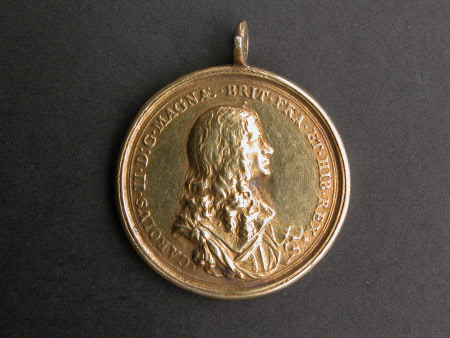Restoration of King Charles II
Thomas Rawlins (1620-1670)
Category
Coins and medals
Date
1660
Materials
Silver-gilt
Measurements
333 x 395 mm
Place of origin
London
Order this imageCollection
Osterley Park and House, London
NT 773262
Summary
Silver, medal commemorating the restoration of King Charles II, by Thomas Rawlins (c. 1620-1670), London, United Kingdom, 1660. A silver-gilt medal by Thomas Rawlins commemorating the restoration as monarch of King Charles II (1630-85, reigned 1660-85), struck 1660. On the obverse a bust profile portrait of Charles II facing right, with the Latin legend translating as ‘Charles II by the Grace of God King of Great Britain, France and Ireland.’ On the reverse three crowns are fitted onto the branches of a leafless oak, above which is a sun bursting through clouds. The legend translates as ‘It will reflourish at last.’ This example was made from separately struck obverse and reverse joined together with a broad rim, to which is attached a suspension ring, allowing to be worn as a pendant.
Full description
After the death of the Lord Protector Oliver Cromwell, a state of indecision and paralysis gripped Parliament and government in London. This was eventually broken by General George Monck, 1st Duke of Albemarle, who brought an army from Scotland to London, and opened negotiations with Charles, who was in exile in the Netherlands. As a prerequisite for his return, Charles made the Declaration of Breda, in which he confirmed his willingness to look to the future rather than the past of the Civil War, and to respect the authority of Parliament. He was then formally invited to return, so set sail from Scheveningen, arriving at Dover on 25 May 1660, where he was greeted by a crowd of 50,000 people. Most of the population was desperate, after more than a decade of Puritan rule, for a return to the old settled order. Thomas Rawlins’ medal thus suggests the optimism that the Restoration of the monarchy engendered in most, if not all, people. As Thomas Reeve wrote in 1661, ‘a king in a commonwealth is like the heart in the body, the root in the tree….the sun in the firmament.’ (Thomas Reeve, England’s Beauty in seeing King Charles II restored, London 1661, p. 48). he leafless tree on the reverse of the medal represents Royalty deprived of its honours, and the three crowns those of England, Scotland and Ireland. The legend explains that, with the restoration of the monarchy, the tree will once again burst into leaf and flourish. Rawlins probably learnt his craft under the French medallist Nicolas Briot, who came to England to work for Charles I (see NT 773246). Rawlins, who was also a playwright, worked at the Oxford mint for Charles I during the Civil War, creating the celebrated Oxford crown. He went into exile in France in around 1648. Although he returned to England in 1652, Rawlins lived a hand-to-mouth existence during the latter years of the Protectorate. He was one of the early beneficiaries of the Restoration, being reinstated as Chief Engraver at the Royal Mint in 1660, and receiving the commission in June 1660 to engrave the king’s effigies for the new coinage. The medal exists in both cast and struck versions. When struck it is usually made from separately struck obverse and reverse united by a broad rim, and equipped with a ring for suspension. There is another version in silver in the medal collection at Osterley Park (NT 773263). Jeremy Warren 2019
Provenance
Given to the National Trust in 1993 by George Child Villiers, 9th Earl of Jersey (1910-1998).
Marks and inscriptions
Obverse, legend: CAROLVS. II. D: G. MAGNAE. BRIT. FRA. ET. HIB. REX. Reverse, legend: TANDEM REVIRESCET
Makers and roles
Thomas Rawlins (1620-1670) , medallist
References
Hawkins, Franks and Grueber 1885: Edward Hawkins, Augustus W. Franks and Herbert A. Grueber (eds.), Medallic Illustrations of the History of Great Britain and Ireland to the death of George II, 2 vols., London 1885, vol.I, p. 453, No. 38. Eimer 2010: Christopher Eimer, British Commemorative Medals and their Values, London 2010, p. 55, no. 215a.
